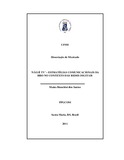| dc.creator | Santos, Maíra Bianchini dos | |
| dc.date.accessioned | 2012-11-16 | |
| dc.date.available | 2012-11-16 | |
| dc.date.issued | 2012-04-02 | |
| dc.identifier.citation | SANTOS, Maíra Bianchini dos. It s Not TV HBO s Communication Strategies in the Context of Digital Networks. 2012. 151 f. Dissertação (Mestrado em Comunicação) - Universidade Federal de Santa Maria, Santa Maria, 2012. | por |
| dc.identifier.uri | http://repositorio.ufsm.br/handle/1/6322 | |
| dc.description.abstract | Understanding the communication strategies adopted by U.S. television network HBO
in the context of digital networks is the goal of this study. The case study contemplates the
online and at a distance observation of an intentional sampling which covers multiple products
and services of the network along its history. In the first part of the paper, HBO s strategic
course is studied from the perspective of Reeves, Rogers and Epstein (1996, 2002, 2006, 2007)
about the ages of TV I, II and III. HBO was the first U.S. cable network to offer exclusive
content to its subscribers and, later, initiated the production of made for TV movies, series and
miniseries among the subscription-based television networks. The second part of the research
discusses the strategies used by HBO starting from the mid-2000s, when the network starts to
consider the digital landscape in which the flow of content produced by television networks
and the mutual exchanges by the public occur among multiple media platforms (Lotz, 2007;
Gabriel 2010). The strategic actions of HBO point to some of the characteristics of the current
television context, which includes strategies that encourage active participation and
conversation among viewers in digital networks, the strengthening of the television network s
own digital presence and the search for complementary platforms for content distribution and
for additional sources of income in the context of the Long Tail (Anderson, 2006). The
strategies adopted by HBO in the last decade allows us to identify the specific dynamics that
rule television in the convergence culture (Jenkins, 2008), which characterize the fourth phase
of American television proposed in this study, the age of TV IV. | eng |
| dc.format | application/pdf | por |
| dc.language | por | por |
| dc.publisher | Universidade Federal de Santa Maria | por |
| dc.rights | Acesso Aberto | por |
| dc.subject | Cultura da convergência | por |
| dc.subject | Estratégias de comunicação | por |
| dc.subject | HBO | por |
| dc.subject | Seriados | por |
| dc.subject | Televisão | por |
| dc.subject | Convergence culture | eng |
| dc.subject | Communication strategies | eng |
| dc.subject | HBO | eng |
| dc.subject | TV series | eng |
| dc.subject | Television | eng |
| dc.title | Não é TV Estratégias Comunicacionais da HBO no Contexto das Redes Digitais | por |
| dc.title.alternative | It s Not TV HBO s Communication Strategies in the Context of Digital Networks | eng |
| dc.type | Dissertação | por |
| dc.description.resumo | Compreender as estratégias comunicacionais adotadas pela rede televisiva norteamericana
HBO no contexto das redes digitais é o objetivo deste trabalho. O estudo de caso
contempla a observação online e à distância de uma amostragem intencional que abrange
múltiplos produtos e serviços da emissora ao longo de sua trajetória. Na primeira parte do
trabalho, o percurso estratégico da HBO é estudado a partir da perspectiva de Reeves, Rogers e
Epstein (1996, 2002, 2006, 2007) sobre as eras da TV I, II e III. A emissora foi a primeira rede
a cabo norte-americana a oferecer conteúdo exclusivo para seus assinantes e, mais tarde,
inaugurou a produção de filmes para a televisão, séries e minisséries entre as redes televisivas
de acesso fechado. A segunda parte da pesquisa aborda as estratégias utilizadas pela HBO a
partir de meados dos anos 2000, quando a emissora passa a considerar o cenário digital no
qual o fluxo de conteúdos produzidos pelas redes de televisão e as trocas recíprocas por parte
dos públicos ocorrem entre múltiplos suportes midiáticos (Lotz; 2007; Gabriel, 2010). As
ações estratégicas da HBO apontam para algumas das características da presente configuração
televisiva, as quais incluem as ações que incentivam a participação ativa e a conversação entre
os espectadores em redes digitais, o fortalecimento da presença digital própria da rede de
televisão e a busca por plataformas complementares de distribuição de conteúdo e por fontes
adicionais de renda no contexto da Cauda Longa (Anderson, 2006). As estratégias adotadas
pela HBO na última década permitem identificar as dinâmicas específicas que regem a
televisão na cultura da convergência (Jenkins, 2008), as quais caracterizam a quarta fase
televisiva norte-americana proposta neste trabalho, a era da TV IV. | por |
| dc.contributor.advisor1 | Mielniczuk, Luciana Pellin | |
| dc.contributor.advisor1Lattes | http://buscatextual.cnpq.br/buscatextual/visualizacv.do?id=K4784639J6 | por |
| dc.contributor.referee1 | Amaral, Adriana da Rosa | |
| dc.contributor.referee1Lattes | http://lattes.cnpq.br/8210260553342144 | por |
| dc.contributor.referee2 | Barichello, Eugenia Maria Mariano da Rocha | |
| dc.contributor.referee2Lattes | http://buscatextual.cnpq.br/buscatextual/visualizacv.do?id=K4784154Y3 | por |
| dc.contributor.referee3 | Pozobon, Rejane de Oliveira | |
| dc.contributor.referee3Lattes | http://buscatextual.cnpq.br/buscatextual/visualizacv.do?id=K4773760U4 | por |
| dc.creator.Lattes | http://lattes.cnpq.br/9121560227805932 | por |
| dc.publisher.country | BR | por |
| dc.publisher.department | Comunicação | por |
| dc.publisher.initials | UFSM | por |
| dc.publisher.program | Programa de Pós-Graduação em Comunicação | por |
| dc.subject.cnpq | CNPQ::CIENCIAS SOCIAIS APLICADAS::COMUNICACAO | por |


